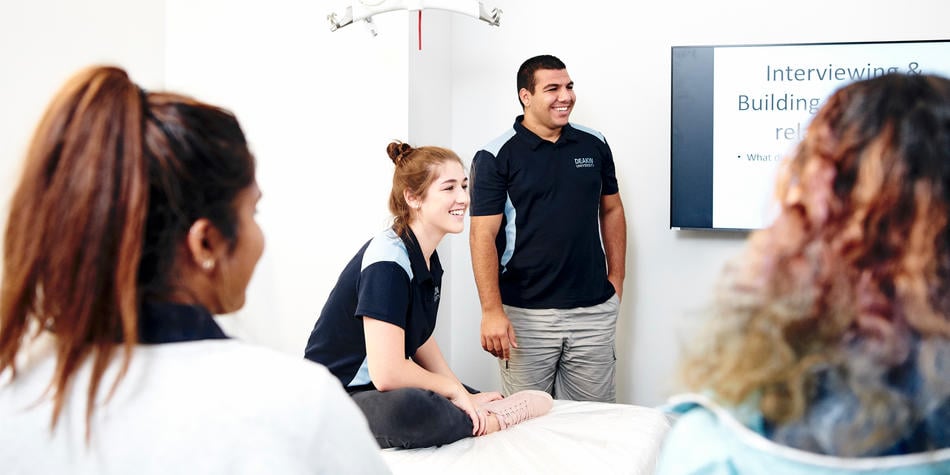Working as an occupational therapist
Hospitals, schools, community health centres, aged care facilities, mental health settings, drug and alcohol services, private clinics, corporate and government agencies are just some of the workplaces where you might find an occupational therapist.
Occupational therapists, or OTs, provide support to people whose health makes it difficult to do everyday tasks – that is, the things that ‘occupy’ them. They identify strengths and difficulties and help with solutions, enabling people to lead active, healthy and productive lives.
‘Occupational therapy covers every single activity that we do during the day,’ says Associate Professor Genevieve Pepin from Deakin’s School of Health and Social Development. ‘It could be getting out of bed or putting on your clothes independently, all the way through to more complex things like answering questions over the phone or being able to do all the tasks that make up your job.’
It’s a diverse, broad and incredibly rewarding career that’s experiencing significant growth as organisations across the country recognise the value of this unique helping profession.
Understanding occupational therapy
When it comes to jobs that help people, occupational therapy is one of the most wide-ranging, but there are some activities common to the average OT’s workday, explains Assoc. Prof. Pepin. ‘We spend much of our time performing assessments to identify our clients’ strengths and areas where they might need an occupational therapist to help them enhance their skills, develop new skills or find ways of doing things differently according to their personal circumstances.'
Helping clients implement treatment strategies is another important task. Occupational therapists work with people admitted to hospital after a stroke or brain injury to assess and treat cognitive impairment and help people with mental health issues live independently. In schools, they work in classrooms helping children develop skills like handwriting and computer skills, and use play to address learning and behavioural difficulties.
Occupational therapists also work with people who have experienced a change in their physical and cognitive abilities to identify and purchase equipment like wheelchairs and bathroom safety devices, or make changes to their home or workplace, so they can live and work comfortably.
‘When working with a client who needs specific equipment like a wheelchair or technology device to maintain their independence at home, OTs spend time writing funding applications to get the right equipment,’ Assoc. Prof. Pepin says.
No matter where we work or who we work with, occupational therapists are working with people who are facing challenges, so it can be quite emotional and their family members or carers might have a lot of questions, so you have to have people skills.
Associate Professor Genevieve Pepin
School of Health and Social Development
Choosing a career in occupational therapy
Sound interpersonal skills and the ability to develop a natural connection with people from all walks of life are essential for a career in occupational therapy. ‘Being able to relax and engage with people and having good communication skills is really important,’ Assoc. Prof. Pepin says.
An ability to construct creative, evidence-based solutions to unique and challenging problems is another must-have. ‘You have to think outside the box because each person is different,’ Assoc. Prof. Pepin says. ‘A specific intervention may work with someone with a specific health condition, but for someone else with the same diagnosis the intervention is going to be very different because that person is different, and their circumstances are different.
‘You also need to have curiosity from a research perspective to make sure your interventions are up-to-date, evidence-based and most appropriate for your clients.
Gaining an occupational therapy qualification
To practice as an OT you’ll need to have a degree in occupational therapy and be registered with the Australian Health Practitioner Registration Agency (AHPRA). All courses must provide students with 1000 hours of clinical placement or practice education. ‘The difference at Deakin is we provide more than that,’ Assoc. Prof. Pepin says.
In fact, Deakin’s Bachelor of Occupational Therapy students complete eight different placements over the duration of the four-year course, Assoc. Prof. Pepin explains. ‘The placements become more and more complex, and the length increases as students progress through the course.’
In second year, students complete a simulated placement, which includes a suite of case studies and interactive learning opportunities. ‘It’s a safe space for students to make mistakes and learn from their mistakes,’ Assoc. Prof. Pepin says.
As a result, employers say Deakin graduates are highly sought-after because they’re job-ready on day one. ‘We’ve been hearing from employers that Deakin students are ready to start working right away,’ Assoc. Prof. Pepin says.
‘They want our students because they can problem-solve, they demonstrate really strong clinical reasoning, they embed research into their practice and make sure they use evidence-based interventions, and they're good at engaging and building rapport with clients.’
Promote health and wellbeing in all aspects of daily life with Deakin’s Bachelor of Occupational Therapy.

